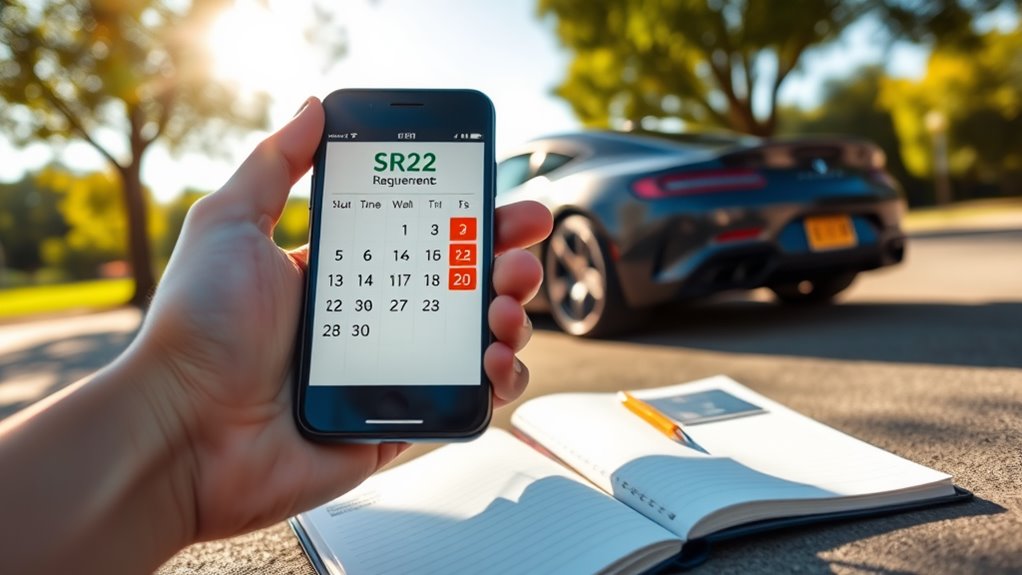5 Best Tips for SR22 Insurance Renewal
Renewing your SR22 insurance can feel like maneuvering through a maze, but understanding a few key points can simplify the process. Knowing the duration requirements and staying on top of your renewal dates are vital. You don't want to risk a coverage lapse that could lead to fines or higher premiums. So, what are the best strategies to guarantee a smooth renewal? Let's explore some essential tips that can help you maintain your coverage effectively.
Key Takeaways
- Monitor your SR22 duration and ensure compliance to avoid fines or extended requirements.
- Set reminders for insurance renewal dates to prevent gaps in coverage.
- Maintain continuous insurance coverage to protect your driving privileges and avoid penalties.
- Communicate regularly with your insurer to stay informed about policy terms and compliance.
- Compare quotes from different insurers to find the best rates and coverage options.
Understand Your SR22 Duration Requirements

Understanding your SR22 duration requirements is important for maintaining compliance and avoiding penalties. Typically, SR22 obligations last between one to three years, depending on your state and the severity of your offense. For instance, California generally mandates SR22 for three years, but more severe cases, like reckless driving, could extend the requirement up to ten years. States like Alabama and Arizona also follow similar rules for serious offenses. The duration starts from the date of the offense that triggered the SR22. It's imperative to stay informed about your specific state's regulations, as non-compliance can lead to fines, license suspension, or even an extended requirement period. Additionally, many states require that you maintain minimum liability insurance coverage throughout this time, which is essential for staying compliant. Keeping your coverage active throughout this time is essential for staying compliant. To ensure adherence, you may need to file an SR-22 certificate with your insurance provider, confirming your liability insurance.
Monitor Your Insurance Renewal Dates
While keeping track of your insurance renewal dates might seem like a minor task, it plays an essential role in maintaining continuous coverage, especially when managing SR22 requirements.
Car insurance policies typically last six months to a year, so regular review is necessary. Insurers often send renewal notices 30 days in advance, outlining expiration details. If you miss these deadlines, you risk coverage lapses, which can lead to higher premiums or penalties.
Setting reminders helps prevent unplanned gaps. Additionally, consider enrolling in automatic payments to guarantee timely premium deductions, but be mindful of credit or debit card expiration dates.
Setting reminders and using automatic payments can help ensure your insurance coverage remains uninterrupted.
Regularly monitoring your policy and payment methods can help you navigate the SR22 process smoothly.
Maintain Continuous Coverage
Maintaining continuous coverage is essential for meeting SR22 requirements and avoiding potential penalties. Gaps in your insurance can lead to serious consequences, such as driver's license suspension and costly reinstatement fees.
By keeping your policy active, you guarantee compliance with state laws and protect your driving privileges. A lapse could also result in higher premiums when you seek reinstatement, as insurers view coverage gaps as a sign of increased risk.
Additionally, maintaining uninterrupted coverage helps build a positive insurance record, which could lead to better rates in the future.
To manage this effectively, plan ahead and prioritize your insurance needs to avoid financial setbacks and secure your driving rights.
Communicate With Your Insurer Regularly

Effective communication with your insurer is vital for maneuvering the complexities of SR22 insurance. By regularly reviewing your policy terms, you'll stay informed about the SR22 requirements and compliance with state-specific regulations.
Open communication channels allow you to promptly address any questions or issues that arise, building trust with your insurer. Additionally, addressing your claims history can enhance your insurability, so don't hesitate to discuss risk mitigation strategies.
Maintaining good credit scores is also important, as they can lead to lower rates. Automating renewal processes and utilizing self-service options can streamline your experience, while regular reminders will help guarantee you take timely action.
Stay proactive, and keep the lines of communication open for a smoother renewal process.
Check for Changes in Premiums and Coverage
As you approach your SR22 insurance renewal, it's important to check for any changes in premiums and coverage. Your premiums might decrease after the SR-22 period, but they may not return to previous rates.
Since the SR-22 filing indicates high-risk status, it could have raised your premiums by 15-40%. To find potential reductions, get multiple quotes from different insurance companies.
Adjusting your coverage levels is also important; consider dropping to liability only for older vehicles to lower costs. However, maintaining appropriate coverage is necessary to avoid unexpected expenses.
Don't forget to ask about discounts for safety features or good credit. Staying informed can help you make the best decision for your insurance needs.
Conclusion
Renewing your SR22 insurance doesn't have to feel like climbing Mount Everest. By understanding your duration requirements, keeping an eye on renewal dates, and maintaining continuous coverage, you can navigate the process smoothly. Regular communication with your insurer guarantees you stay informed, while shopping around can help you find the best rates as your SR22 period comes to a close. Follow these tips to safeguard your driving privileges and keep your insurance premiums manageable.




